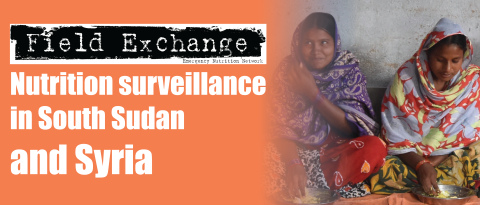Further perspectives on scurvy outbreak
This is a poscript for the field article 'Scurvy outbreak among South Sudanese adolescents and young men – Kakuma refugee camp, Kenya, 2017-2018', which you can read here.
Marie McGrath and Jeremy Shoham, Field Exchange editors, interviewed Mija-Tesse Ververs, who undertook the field trip with CDC to investigate the scurvy outbreak, for more insights.
Q: It seems these adolescent boys were the only population group that was affected by this outbreak. Is that correct? Regarding the context in which these young men were living, could you elaborate more on their social circumstances?
The adolescent boys who were affected by this outbreak were fleeing war. They had no source of income and were diligently attending and enjoying school in the camps. This meant they were wholly dependent on food assistance and cash for their nutrition. As far as we know, these young men were the only population group that was affected by this outbreak. The CDC/UNHCR investigation focused mostly on these cases and their situation. Having an adult woman in the household seemed to be a protective factor in this population. Some of these boys had arrived into the camp at 10-14 years of age, having never learned to cook or garden or know what a healthy diet was.
Q: What impact did this situation have on the boys?
Scurvy had a significant personal impact on these boys. The highlight of their day was attending school and playing football. The physical consequences meant they could not play football, which had a considerable psychological impact on them; some had become demoralised and a few expressed thoughts of returning back to South Sudan “to pick up weapons to fight for their own food”. In general, the condition did not heighten school dropout if they could still walk, reflecting their commitment to their schooling.
Q: Regarding the findings on the CSB+ vitamin C losses in preparation, how does this compare with other official quality control data? What do you think are the implications of the findings regarding CSB+ more broadly and what actions do you think are needed?
Vitamin C retention was less than expected by WFP. Based on literature, they expected a 50% retention. Poor retention is not just due to heat liability of vitamin C, but mostly oxidation, which leads to losses. Oxidation is affected by preparation method – the more a cooking pot of CSB is stirred, the more oxygen is introduced and the greater the loss.
We need to establish whether CSB needs to be a source of vitamin C. If the answer is yes, then we need more studies on how to prevent losses in preparation and to examine if higher levels of fortification can prevent loss. If not, then we need to make sure to accommodate vitamin C from another source. The findings also raise concern about other vitamins – vitamin C deficiency may be a proxy for other sub-clinical deficiencies.
Q: What do you think were the key contributing factors to this outbreak?
The adolescent boys lived together as a group and prepared their meals together. They ate all the CSB obtained within the first few days of receiving it. This meant that they had no intake of vitamin C, as a water-soluble vitamin, for the rest of the month. However, this was not the main issue. A more critical contributing factor to this outbreak was the cut in food assistance leading to reduced rations of staple foods distributed. Cash programming was initiated to partly compensate for less ‘in-kind’ food provision and to facilitate food diversification, such as purchase of fruits and vegetables. However, without adequate amounts of staple foods in the general ration, cash subsidies were used by these boys to purchase staples rather than fruit and vegetables, as was intended.
The higher nutrient requirements of adolescent boys were also a critical factor. Active, growing adolescent males have a high caloric demand; ration targets of 2,100 kcal/day based on ‘average’ household composition are inadequate for young men, who need closer to 3,000 kcal/day. We did not look to see if these boys were acutely malnourished, but this is also not easy to diagnose within the Dinka population, whose physique is typically lean and tall.
When household demographics are skewed, as in this case or, for example, in contexts with peace-keepers (military dominated by males), young male migrants (as in the European migrant crisis), or in prisons (where we have also seen scurvy outbreaks), energy and nutrient estimates based on average households are not adequate. Differences in demographics and energy and nutrient requirements do not just apply to men; women may also be disproportionately represented and have heightened needs, such as for iron, and the response should be contextualised accordingly.
What immediate key action would you like to see?
We need to examine and change our way of ‘doing business’ when it comes to nutrition-assistance targets. Currently, the NutVal1 programme includes adolescent boys and girls as one group. As a priority, this should be revised to distinguish boys and girls to accommodate their different energy and nutrient needs and so facilitate more appropriate food-assistance planning.
Endnote
1www.nutval.net


